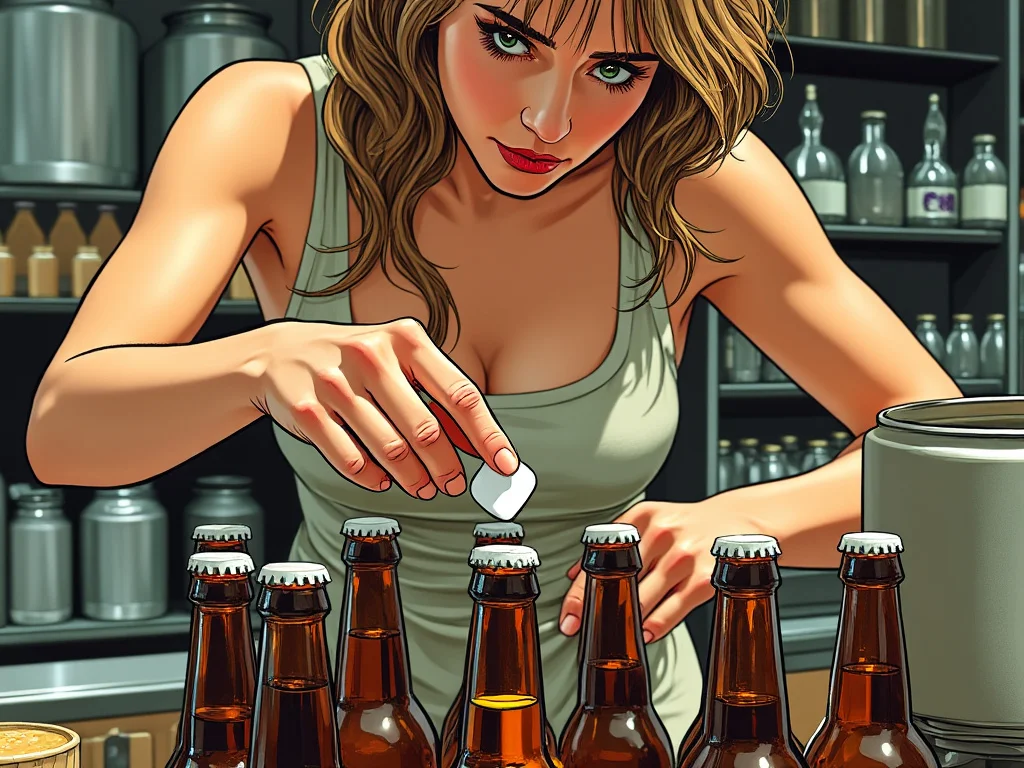Using Carbonation Drops A Guide to Easy Beer & Cider Bottling
A common way to bottle beer or cider is to add sugar to each bottle individually using a spoon or by batch priming. That can be messy or take a bit of time. For faster bottling times, many brewers use carbonation drops to make bottling quick and error-free. Once the beers have been sealed with a drop safely inside, the process of secondary fermentation begins as the yeast eats the sugar in the drops. Too easy!
🤔What are Carbonation Drops?
Key Takeaway:Pre-measured Doses of Sugar
What are the ingredients of carbonation drops? Sugar. That's it, sucrose or dextrose is the only ingredient. So there is no difference between a carbonation drop and a measured dose of sugar. The entire reason for using them is simply for ease of use. The science behind them is based on priming: the yeast consumes the sugar, producing carbon dioxide (CO2) as a byproduct. In a sealed bottle, this CO2 dissolves into the beer, creating carbonation.
Using drops ensures that each bottle is given the same sugar dosage, which allows for a consistent brew and helps prevent 'gushers'. Because the drops are just simple sugar and used at low volumes, they leave no 'off-tastes' in your beer. Popular brands like Coopers Carbonation Drops and Mangrove Jack's are reliable and widely available.
🍾How Do You Use Them?
Key Takeaway:The Easiest Step in Brewing
It's actually probably the easiest part of making beer! Once you have added the beer to your sanitized bottles, all you need to do is literally drop a carbonation drop into each bottle. Instantly, you are done. Easiest instructions you will follow all week! You then cap the bottle so that carbonation can commence and the CO2 becomes trapped inside.
🔢How Many Drops Per Bottle?
Key Takeaway:Dosage Depends on Bottle Size & Style
It's not an exact piece of maths but here are the standard practices:
- 1 drop for a standard 330ml to 375ml (12 oz) bottle. This dosage also works well for bottles up to 500ml for a standard level of carbonation.
- 2 drops for a 750ml bottle (your standard "long neck" or wine-size bottle).
- For anything bigger like a one-litre bottle, you may wish to consider 2 and a half drops or possibly 3, but you're risking over-sugaring your beer, which may cause beer gushers.
Style matters: Ales generally need less sugar than lagers. For a standard ale, one drop per 375ml is perfect. For a highly carbonated style like a Belgian Ale or German Hefeweizen, you might consider slightly more, but proceed with caution to avoid over-carbonation.
⏱️How Long Do They Take to Work?
Key Takeaway:Carbonation is Quick, Conditioning Takes Time
The same amount of time as simply adding sugar does! Basically, carbonation will take place fairly quickly, a matter of days. However, a good length of time is then needed to let your beer condition properly and we recommend an absolute minimum of 2 weeks for that (we won't begrudge you a taste tester one though eh?). At three weeks your beer should be beginning to become quite drinkable, but as usual, we suggest you wait till that fifth week if you can be so patient.
A wee bit of advice: when you do your first taste, lower your expectations and secondly, make sure you have chilled your bottle in a fridge overnight. The lower temperature helps the CO2 stay dissolved in the beer and can reduce excessive fizz when you open the bottle. Don't believe me? Open a warm brew that's had a little too much sugar added...
💊Tablets vs. Drops
Key Takeaway:An Alternative with More Ingredients
You can also use 'carbonation tablets' or (conditioning tablets) for bottling, which is a different way to carbonation glory. The tablets usually contain dextrose, dry malt extract, and heading powder, which is clearly different from using sugar for fermentation. Given the ingredients, they will add more flavour and body to your beer. The usage is typically 3, 4, or 5 tablets per 12-ounce bottle for low, medium, or high carbonation. Popular brands are Muntons' 'Carbtabs' and Brewer's Best Conditioning Tablets.
🦠Do I Need to Sterilize Them?
Key Takeaway:No, It's Not Necessary
No, you do not need to take such a step. If you take the drops straight from a freshly opened packet and use clean hands, you should be absolutely fine. No one ever sterilizes their sugar when brewing so we don't see any reason to do this. I have a bag of sugar that I keep in my brewing shed. It's in a plastic container but it's manky - I've never had any issues with using sugar that's not sterilised. You just don't need to do it.
💡Final Tips & Tricks
Key Takeaway:Quick Pointers for Success
- You can use drops to carbonate apple cider. The measurements are the same. Just as with beer, be wary of over-carbonating the cider.
- Remember that Priming sugar
and corn sugar are both simply dextrose.
- If you choose not to use drops, we recommend a sanitized kitchen funnel
to reduce mess.
- You can use drops with your ginger beer as well! And though we've never tried it, maybe your hard seltzer.
- You can use a Soda Stream machine to carbonate your beer, but be careful!

















0 comments:
Post a Comment